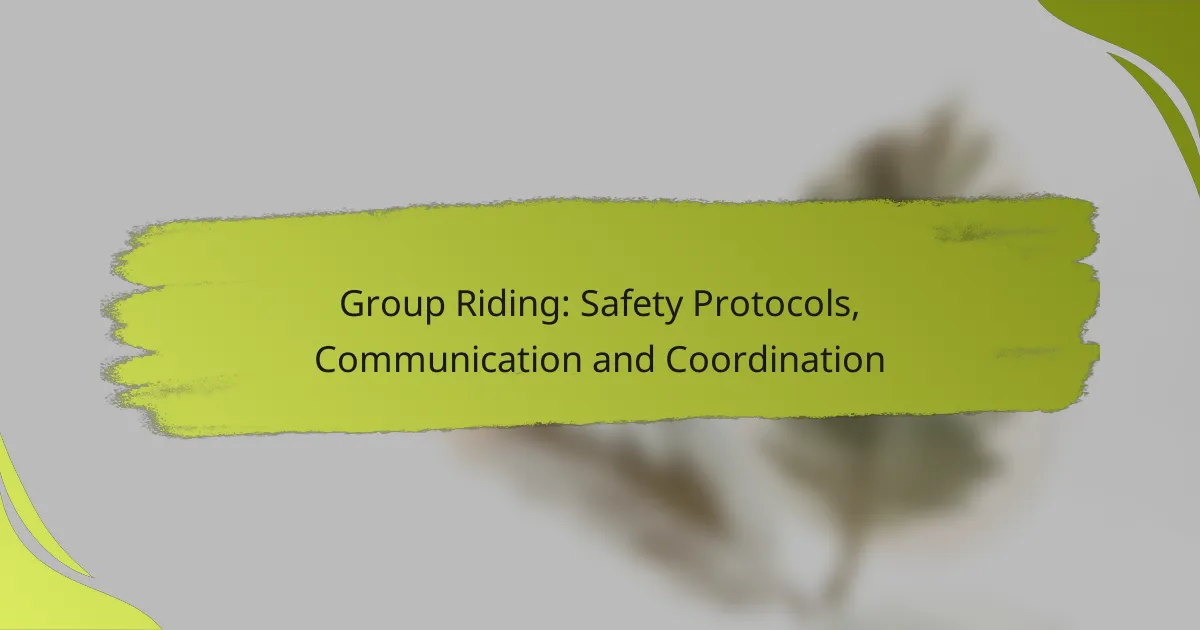Group riding requires a strong emphasis on safety protocols to minimize risks and ensure smooth coordination among all participants. Essential practices include wearing appropriate safety gear, maintaining safe distances, and using hand signals, alongside establishing a leader and sweep for effective group management. Clear communication through verbal cues and visual signals is vital, as is the implementation of coordination strategies like consistent pacing and planned rest stops to enhance the overall riding experience.

What are the safety protocols for group riding in the UK?
Safety protocols for group riding in the UK focus on minimizing risks and ensuring smooth coordination among riders. Key practices include wearing appropriate safety gear, maintaining safe distances, using hand signals, establishing a leader and sweep, and conducting pre-ride briefings.
Wearing appropriate safety gear
Wearing appropriate safety gear is crucial for protecting riders during group rides. This typically includes a well-fitted helmet, gloves, and reflective clothing to enhance visibility, especially in low-light conditions.
Additional protective gear, such as padded jackets and knee or elbow guards, can further reduce injury risk. Riders should ensure their gear meets UK safety standards and is in good condition before each ride.
Maintaining safe distances
Maintaining safe distances between riders is essential to prevent collisions and allow for safe maneuvering. A common guideline is to keep a gap of at least two seconds between bikes, which provides adequate reaction time.
Riders should adjust their distance based on speed and road conditions. In wet or slippery conditions, increasing the distance is advisable to account for longer stopping distances.
Using hand signals
Using hand signals is vital for effective communication in a group ride. Riders should signal turns, stops, and hazards clearly to ensure everyone is aware of the group’s movements.
Common signals include extending an arm to indicate a turn and holding a hand up to signal a stop. Practicing these signals before the ride can enhance coordination and safety.
Establishing a leader and sweep
Establishing a leader and a sweep rider helps maintain order during the ride. The leader sets the pace and navigates the route, while the sweep ensures that no rider is left behind and assists those who may struggle.
This structure allows for better management of the group and helps address any issues that arise during the ride, such as mechanical failures or fatigue.
Conducting pre-ride briefings
Conducting pre-ride briefings is an effective way to ensure all riders understand the route, safety protocols, and group dynamics. Briefings should cover the planned route, expected stops, and any specific challenges along the way.
Encouraging questions during the briefing can clarify any uncertainties and foster a sense of teamwork. This preparation can significantly enhance the overall safety and enjoyment of the ride.

How to communicate effectively during group rides?
Effective communication during group rides is essential for safety and coordination. Riders should use a combination of verbal cues, radio communication, and visual signals to ensure everyone is aware of their surroundings and intentions.
Utilizing verbal cues
Verbal cues are simple spoken commands or alerts that help maintain group awareness. Riders should agree on a set of standard phrases for common situations, such as “slowing down,” “stopping,” or “obstacle ahead.” This ensures that everyone understands the immediate actions required.
When using verbal cues, speak clearly and loudly enough for others to hear, especially in noisy environments. Avoid jargon or complex terms that may confuse group members. Practicing these cues before a ride can enhance familiarity and responsiveness.
Implementing radio communication
Using radios can significantly improve communication over longer distances or in larger groups. Riders should select a reliable radio system that operates on clear frequencies to avoid interference. Ensure all members are familiar with the device’s operation before the ride.
Establish a protocol for radio use, including how to initiate communication and respond to messages. Keep messages concise and relevant to avoid cluttering the channel. Regularly check in with the group to confirm everyone’s status and location.
Using visual signals
Visual signals are essential for conveying information quickly without verbal communication. Riders can use hand signals to indicate turns, stops, or hazards. Standardizing these signals helps ensure everyone understands the intended message.
In addition to hand signals, consider using reflective gear or flags to enhance visibility, especially in low-light conditions. Riders should practice these signals during training rides to ensure everyone is comfortable and responsive during actual group rides.

What coordination strategies enhance group riding?
Effective coordination strategies are essential for safe and enjoyable group riding. These strategies include establishing a consistent ride pace, designating rest stops, and planning route navigation to ensure all riders are aligned and informed throughout the journey.
Establishing ride pace
Setting a ride pace is crucial for maintaining group cohesion and safety. The pace should accommodate the slowest rider’s comfort level, typically falling within a range of 12 to 18 miles per hour for recreational rides. This ensures that no one is left behind and that the group can ride together effectively.
To establish the ride pace, communicate clearly before the ride begins. Use hand signals or verbal cues during the ride to adjust speed as needed, especially when approaching hills or varying terrain. Avoid sudden accelerations that can lead to accidents or disbanding the group.
Designating rest stops
Designating rest stops allows riders to recharge and regroup, enhancing the overall experience. Plan for breaks every 15 to 30 miles, depending on the group’s endurance and the ride’s duration. Choose safe locations, such as parks or gas stations, where riders can comfortably rest and hydrate.
Communicate the planned rest stops before the ride starts and ensure everyone knows the schedule. Encourage riders to take advantage of these breaks to check their gear and discuss any concerns, fostering a sense of community and support within the group.
Planning route navigation
Planning the route is vital for smooth group riding. Use reliable navigation tools, such as GPS apps or printed maps, to outline the journey and highlight key turns and landmarks. Share this information with all riders to prevent confusion and ensure everyone stays on track.
Consider the skill levels and preferences of the group when selecting the route. Avoid overly complex paths or high-traffic areas that may pose safety risks. Regularly check in with the group during the ride to confirm everyone is comfortable with the navigation and adjust as necessary.

What are the common challenges in group riding?
Group riding presents several challenges, including managing varying skill levels, dealing with adverse weather, and addressing mechanical issues. Each of these factors can significantly impact the safety and enjoyment of the ride.
Managing different skill levels
In any group ride, participants will often have different levels of experience and skill. This disparity can lead to safety risks if not properly managed, as less experienced riders may struggle to keep up or navigate complex situations.
To address this, it’s crucial to establish a clear pace that accommodates the least experienced rider. Consider organizing the group into smaller sub-groups based on skill level, allowing faster riders to enjoy their pace while ensuring that everyone feels comfortable and safe.
Dealing with adverse weather conditions
Adverse weather can pose significant challenges during group rides, affecting visibility, traction, and overall safety. Rain, fog, or strong winds can create hazardous conditions that require extra caution.
Before heading out, check the weather forecast and be prepared to adjust your plans accordingly. If conditions worsen during the ride, consider finding shelter or altering the route to avoid dangerous areas. Always ensure that all riders are equipped with appropriate gear, such as waterproof clothing and reflective accessories.
Addressing mechanical issues
Mechanical issues can arise unexpectedly during a group ride, potentially stranding a rider or causing delays. Common problems include flat tires, brake failures, or chain issues, all of which can disrupt the group’s flow.
To mitigate these risks, encourage all riders to perform a pre-ride inspection of their bikes, checking tires, brakes, and gears. Carry basic repair tools and spare parts, such as tubes and tire levers, to address minor issues on the spot. Establish a plan for handling significant mechanical failures, including how to safely regroup and assist the affected rider.

How to choose the right group riding gear?
Selecting the right group riding gear is essential for safety and comfort. Focus on high-quality helmets, suitable bike models, and appropriate clothing to enhance your riding experience and ensure effective communication with your group.
Evaluating helmet options
When choosing a helmet for group riding, prioritize safety certifications such as DOT, ECE, or Snell. These standards ensure that the helmet meets specific safety requirements to protect your head in case of an accident.
Consider features like ventilation, weight, and fit. A well-ventilated helmet can keep you cool during long rides, while a lightweight design reduces fatigue. Ensure the helmet fits snugly without being uncomfortable, as this will enhance both safety and comfort.
Comparing bike models
Selecting the right bike model is crucial for group riding dynamics. Consider factors such as frame size, weight, and type of bike—road, mountain, or hybrid—to match the group’s riding style and terrain.
Test ride different models to assess handling and comfort. Look for bikes that offer features like drop handlebars for aerodynamics or wider tires for stability, depending on the riding conditions you expect to encounter.
Assessing clothing for comfort
Comfortable clothing is vital for enjoyable group rides. Opt for moisture-wicking fabrics that keep you dry and cool, especially during extended rides. Look for padded shorts to enhance comfort on the saddle.
Layering is also important; consider lightweight, breathable layers that can be added or removed based on changing weather conditions. Avoid cotton, as it retains moisture and can lead to discomfort during long rides.
